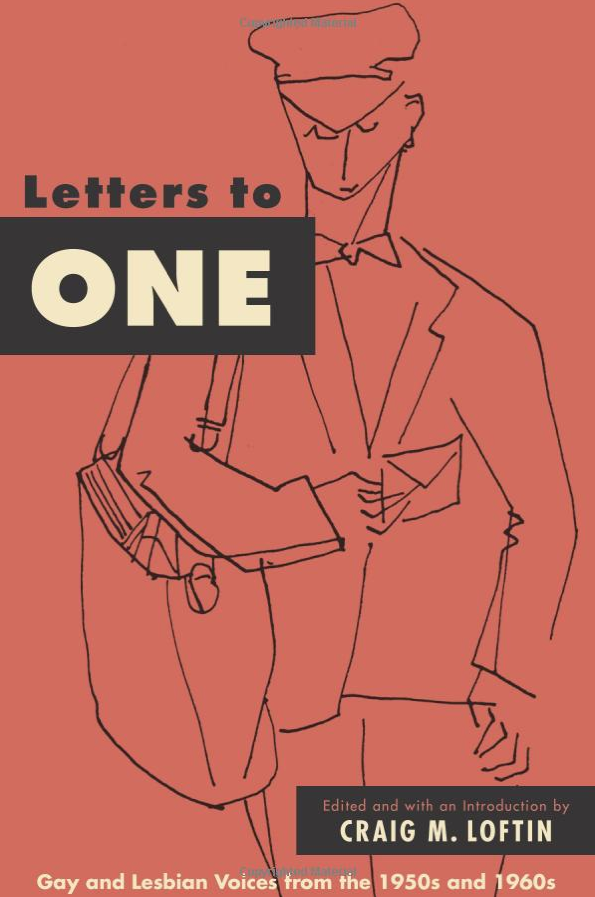Donna Knaff
“Letter writing,” Craig M. Loftin begins the introduction to his book, “is a dying craft” (p. 1). Using letters sent to ONE, the first openly gay magazine in the United States, Letters to One: Gay and Lesbian Voices from the 1950s and 1960s is an interesting look at the lives of gay men and lesbians from that era. ONE, Inc., was “one of three major ‘homophile’ organizations of the 1950s and 1960s,” Loftin explains. He combed through a large collection of unlabeled boxes in the ONE archives to find letters that captured the “fears, anxieties, and disasters that befell gay people during these years of McCarthyite repression and institutionalized homophobia,” and that also demonstrated the growth of post-WWII gay and lesbian groups (p. 3).
The worth of these letters lies in the histories of self-identified gay men and lesbians from the critical pre-Stonewall era. Many led lives of subterfuge, secrecy, and thwarted sexuality in order to get or hold jobs and/or families. Their stories of dishonorable discharge from the military, sexual assault, and psychiatric treatment for their “illness” make for a compelling, if often dismaying, insight into their life experiences.
A remarkable feature of many of the letters is the level of expression the writers adopted. Several letters discuss articulately and at length fiction, poetry, film, psychology, theories of homosexuality, drama, and other subjects. Other letters reveal only a pained acquaintance with education, spelling, and grammar, their messages perhaps even more poignant because their authors often had no historical, literary, or cultural context for their persecution. Some writers used the magazine editors and readers as their at-long-last listening ears, a receptive audience for people who have had to conceal their affections and orientations their whole lives. Many letter writers, consciously or unconsciously, showcased what Loftin calls “their resilience and strategic adaptation with a sense of irony and even humor” (p. 3).
Organized into five chapters, entitled “Biography and Self-Analysis,” “Love, Sex, and Relationships,” “Repression and Defiance,” “Incarceration,” and “Representations and Stereotypes,” Letters to One provides a critical insight into the 1950s and 1960s (post-WWII, pre-Stonewall), an era that is as important to historians of gender as the period between the world wars is to historians of war. Once the WWII military, with its “blue” discharges for homosexuality and its “queer stockades,” unwittingly assembled a society of men and women whose shame or condition of discharge kept them from returning home, the cities where they were demobilized (San Francisco, New York, etc.) became the birthplaces of lesbian and gay communities.
Other authors have covered similar topics but with different emphases. In Odd Girls and Twilight Lovers: A History of Lesbian Life in Twentieth-Century America (1991), Lillian Faderman, for example, explores lesbian lives in the 1950s and 1960s through a wide range of sources, including journals, unpublished manuscripts, songs, media accounts, novels, medical literature, pop culture artifacts, and oral histories. Examining the same time period, Loftin narrows his focus specifically to one source—letters to ONE from men and women who were motivated for whatever reason to write to the editor. Loftin’s study presents the stories of more men than women. This is a fact that Loftin acknowledges and explains: many more men than women wrote to One, so the stories of gay men are disproportionately represented. (Interestingly, some female readers did write to One, demanding to know why a lesbian viewpoint was not more represented.)
Although Letters to One is technically a secondary source, it often reads like a primary source. Short of actually visiting the One archive, this work may be the closest that Loftin’s readers will come to hearing the voices of an earlier age of gays and lesbians.
Craig M. Loftin. Letters to One: Gay and Lesbian Voices from the 1950s and 1960s. Albany: State University of New York Press, 2012. 208 pp. $24.95 (paper), ISBN 978-1-4384-4298-3; $75.00 (cloth), ISBN 978-1-4384-4297-6.
This review was published at H-Histsex, H-Net Reviews (October, 2014) and commissioned by Timothy W. Jones.
Donna Knaff is a World War II historian at the Joint POW/MIA Accounting Command and is also former Chief Historian at the Women In Military Service For America Memorial at Arlington National Cemetery. She is author of Beyond Rosie the Riveter: Women of World War II in American Popular Graphic Art

NOTCHES: (re)marks on the history of sexuality is licensed under a Creative Commons Attribution-NonCommercial-NoDerivatives 4.0 International License.
Based on a work at www.notchesblog.com.
For permission to publish any NOTCHES post in whole or in part please contact the editors at NotchesBlog@gmail.com





